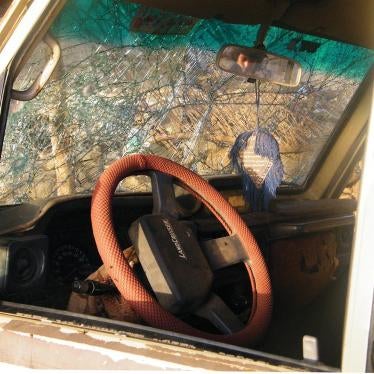(New York) – Syrian forces have placed landmines near the borders with Lebanon and Turkey in recent weeks and months, Human Rights Watch said today, based on reports and confirmations from witnesses and Syrian deminers. Civilian casualties have already resulted, the witnesses said.
The Syrian army should cease its use of antipersonnel landmines and recognize that planting this internationally banned weapon will hurt Syrians for years to come, Human Rights Watch said. Both antipersonnel and antivehicle mines of Soviet/Russian origin have been cleared by deminers associated with the opposition.
“Any use of antipersonnel landmines is unconscionable,” said Steve Goose, Arms Division director at Human Rights Watch. “There is absolutely no justification for the use of these indiscriminate weapons by any country, anywhere, for any purpose.”
Antipersonnel mines are militarily ineffective weapons that mostly kill and injure civilians, Human Rights Watch said. A total of 159 countries have joined the 1997 Mine Ban Treaty, which comprehensively prohibits the use, production, trade, and stockpiling of antipersonnel mines.
Syria has not joined the Mine Ban Treaty, though it is not thought to be a producer or exporter of antipersonnel mines. It is last believed to have used antipersonnel mines during the 1982 conflict with Israel in Lebanon. The size and origin of Syria’s landmine stockpile is not known, but it is believed to consist mainly of Soviet/Russian-manufactured mines, such as the PMN-2 antipersonnel mines and TMN-46 antivehicle mines.
Mines Along the Turkish Border
Multiple accounts by witnesses appear to confirm that the Syrian army has planted landmines near its border with Turkey in 2012:
- A 28-year-old former Syrian army deminer from Jisr al-Shughour in Syria’s northern Idlib Governorate told Human Rights Watch that in January, local residents saw the Syrian army plant landmines at Hasanieih (حسانية), Derwand (دروند) and Jiftlek (جفتلك), along routes used by refugees to reach Turkey. In early February, he visited Hasanieih and found landmines planted “between the fruit trees” 3 meters from the border in two parallel lines, each approximately 500 meters long. Local villagers told him that the army had informed farmers in the area that they need army permission to enter the orchards, but had not told them that the area was mined. At the beginning of March, the deminer, together with his cousin and three volunteers, removed approximately 300 PMN-2 antipersonnel mines from Hasanieih.
- A resident of the Syrian border town of Kherbet al-Joz told Human Rights Watch: “From February 10 to March 1, we saw the Syrian army, around 50 soldiers accompanied by two big military cars, putting landmines starting from Kherbet Aljoz toward Alzouf (الزوف) and al-Sofan (الصوفان). There is a road right on the Turkish side, and they started 20 meters away from it. On March 4 around midnight, we heard a landmine explosion followed by gunfire shooting for 30 minutes from the Syrian side.”
- On February 9, a Syrian opposition fighter told a journalist that a few days earlier he had witnessed Syrian army personnel planting landmines on a parallel path to the one that he was taking to cross the border into Turkey. The fighter said that in January, a vehicle traveling in the border area between Jisr al-Shughour and Al Zawiya had hit an antivehicle mine, causing two casualties.
- A wounded Syrian opposition commander from Idlib told Human Rights Watch that the Syrian army had laid landmines in the following areas near the Turkish border: Kherbet Aljoz, Armana, Bkafla, Hatya, Darkosh, Salqin and Azmeirin. The commander said he had learned this information from people injured by landmines in those areas.
Turkey’s Ministry of Foreign Affairs said on February 16 that it is investigating allegations of Syrian landmine use on the border with Turkey. Turkey acceded to the Mine Ban Treaty on September 25, 2003, and has initiated plans to clear the minefields Turkey placed on its side of the border.
Mines Along the Lebanese Border
The first reports of new mine-laying on the Lebanon border by Syrian forces emerged in November 2011. A Syrian government official told The Associated Press on November 1 that “Syria has undertaken many measures to control the borders, including planting mines.”
On March 9, The Washington Post published a photo of dirt-covered PMN-2 antipersonnel mines and TMN-46 antivehicle mines that it reported were planted by the Syrian army on the outskirts of the Syrian village of Heet near the northern Lebanese border and then dug out by Syrian and Lebanese activists.
A 15-year-old boy from Tal Kalakh in Syria who lost his right leg to a landmine in February told Human Rights Watch:
I was in Tel Kalakh when we received a wounded person from Bab Amr [the Homs neighborhood that was under siege by Syrian troops] who is a friend of the family. My brother who is in Lebanon told me to transfer the wounded person to Wadi Khaled. I waited until it was dark outside, and walked across the fields filled with thorns. I was 50 meters away from where the landmines were planted two months ago. My brother and I had seen them laying the landmines. We were sure that no landmines were planted in the area filled with thorn bushes because after putting the landmines we smuggled several people in and outside Tel Kalakh. That is why I decided to cross from there. I think they planted extra landmines. I was less than 50-60 meters away from crossing the border when the landmine exploded. The injured person died and I was severely injured. My brother waiting for me in his car saw the explosion. He put me in the car and drove away.
Lebanon has not yet acceded to the Mine Ban Treaty, but indicated in December 2009 that it “looks forward to joining the Mine Ban Treaty,” and stated in August 2011, “The Lebanese Government doesn’t use or stockpile or produce or transport any anti-personnel mines.”
Jordan’s border with Syria was mined prior to the current conflict within Syria, but it is not known if Syrian forces have laid new mines on its border with Jordan. Jordan is a state party to the Mine Ban Treaty and in November 2011 said that “increasing tensions” on its northern border with Syria could delay the completion of the country’s landmine clearance program.
Syria is the fourth government reported to use antipersonnel mines since January 2011, joining Libya (under Muammar Gaddafi), Israel, and Burma.
Human Rights Watch is a founding member of the International Campaign to Ban Landmines (ICBL), the 1997 Nobel Peace Prize Laureate. 2012 marks 20 years since the ICBL was established by six nongovernmental organizations at the New York offices of Human Rights Watch in October 1992.





